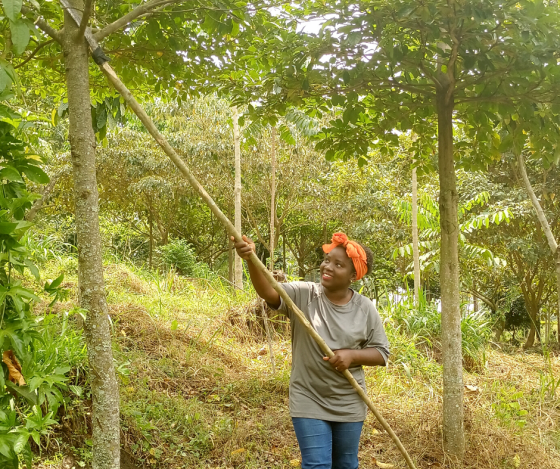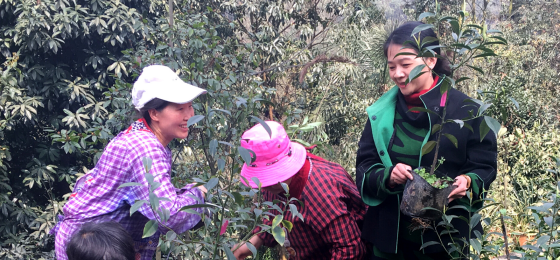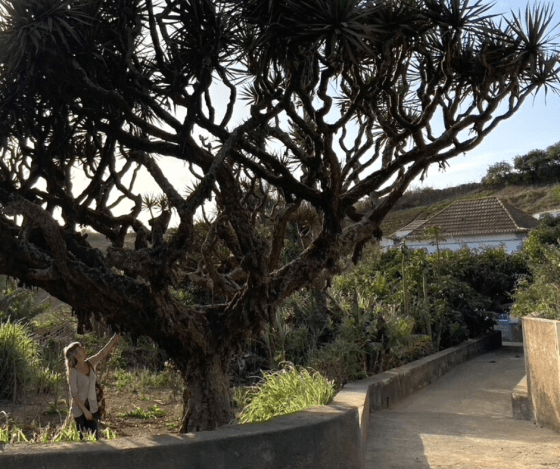Championing the women working with the Global Trees Campaign
-
Topic
Tree Conservation -
Type
Blog -
Source
BGCI
News published: 8 March 2021
Every year, on International Women’s Day, we celebrate the achievements made by women globally. We caught up with eight women from around the world working tirelessly with the Global Trees Campaign (GTC) to find out more about what motivates them to conserve threatened trees and what they believe is most important to ensure these species persist and thrive in the future.

Harreit-Kokugonza-TBG
Harriet Kokugonza pruning Prunus africana at Tooro Botanical Gardens arboretum. Credit: Harriet Kokugonza

Xiangying-Wen-BGCI_
Xiangying Wen and colleagues, Botanical Gardens Conservation International (BGCI), China. Credit: BGCI

Martine-Goder-MWF
Martine Goder of the Mauritian Wildlife Foundation. Credit: Martine Goder

Rasima-Sabzalieva-FFI
Rasima Sabzalieva of FFI’s Tajikistan programme. Credit: Rasima Sabzalieva/FFI

Cristina-Coletto-Biflores
Cristina Coletto with a Cape Verdean dragon tree. Credit: Cristina Coletto

Yu-Daoping-EBG
Yu Daoping carrying out hand pollination. Credit: Yu Daoping

Muqaddas-Milikbekova-FFI
Muqaddas Milikbekova of FFI’s Tajikistan programme. Credit: Muqaddas Milikbekova/FFI
1. What inspired you to begin working to conserve threatened trees?
Muqaddas Milikbekova, Fauna & Flora International (FFI), Tajikistan: “As a young girl, I used to see my mother collecting different crops and leaves to make a herbarium. Her amazing collection of preserved fruit plant specimens always inspired me and made me close to nature and plants.”
Martine Goder, Mauritian Wildlife Foundation, Mauritius: “Mauritius has a very diverse flora, with 691 species of native plants out of which 273 are endemic. However, less than 2% of native forest is left and over 90% of the endemic Mauritian plant species are now threatened with extinction. I realised that if we do not intervene by restoring forests and recovering these unique, highly threatened species, they will follow the same fate as our dodo, which has become the symbol of extinction. I have dedicated the past 15 years to this conservation; it is often challenging but I am happy to work towards saving these threatened species.”
Xiangying Wen, Botanical Gardens Conservation International (BGCI), China: “I was born in a mountainous area. I touched plants almost every day during my childhood, since I helped my parents feed the pigs and fish, so I loved plants a lot. That is why I chose plant taxonomy as my major when I studied my master’s degree. In 2007, BGCI provided me a great opportunity for working on the conservation of threatened plant species. From then on, I paid great attention to threatened plants, especially tree species.”
Cristina Coletto, Biflores, Cape Verde: “I love nature and since I was a child, I always enjoyed walking in the woods and stop to relax under the trees. You can feel protected by them. But it was when I lived in very arid areas of East Africa that I realised the power and importance of a tree: even only the shadow of a tree can be a big relief for people and animals, and it is of course the main aggregation and meeting point.”
Harriet Kokugonza, Tooro Botanical Garden, Uganda: “My favourite threatened tree species are Citropsis articulata, Olea welwitschii (both of which are nationally threatened) and Prunus africana. The utilisation of these species for cultural ecosystem services to promote human heritage and attachment to the wild threatened species in our community inspired me to work on conservation of threatened species so that we can continue enjoying their benefits.”
Rasima Sabzalieva, FFI, Tajikistan: “I can assuredly say that my first inspiration for conserving trees and my role model is my grandfather, who is unfortunately no longer with us. He made sure that his next generation enjoy the fruits of his own planted trees and are aware of the importance of continuing the same tradition.”
Raheela Ahmed, Mulanje Mountain Conservation Trust, Malawi: “Working regularly on Mt Mulanje has revealed to me a unique landscape and a very diverse vegetation – many of the plant species of which are endemic – and this has inspired me to conserve the most iconic of all – the Mulanje Cedar. I was fortunate to be in the team that discovered the last remaining coning cedar specimen on the mountain and the observations of this last mature tree highlighted the exceptional symbiotic relationships it has within the forest.”
2. What is your favourite threatened tree species that you are currently working to conserve and what are the challenges involved with this work?
Yu Daoping, Emeishan Botanical Garden, China: “My favourite threatened tree species is Magnolia omeiensis, a Critically Endangered species that is distributed in Mount Emei, Sichuan Province. This species can be used as an ornamental, but the challenge we encountered is local communities are not highly motivated to participate in conservation”
Raheela Ahmed: “The Critically Endangered tree species that I am currently helping to conserve is the endemic Mulanje cedar, Widdringtonia whytei, that is found only on Mt Mulanje in Malawi. This magnificent tree can grow up to 40 metres, has a richly fragrant essential oil, and produces a fine-grain timber that is valuable for many specialist uses. Mulanje cedar grows within the high-altitude cloud forests on Mt Mulanje and is a critical keystone species within this habitat. The main threats to this beautiful tree are illegal harvesting, habitat destruction and wildfires.”
Muqaddas Milikbekova: “Working closely with the tree species in the project sites, I fell in love with all varieties of trees, but Critically Endangered pear species (within the Pyrus genus) are my favourites. They are special with their unique structure, marvellous flowers and juicy, sweet pears. I wouldn’t be wrong to call the pear tree a “Queen of trees” as the shape of the pear is reminiscent of the female form and creates a strong symbol of femininity. As community livelihoods highly depend on forest products, in particular dried and fresh fruits, pear species and other threatened trees are under pressure from overharvesting, illegal cutting of trees for fuel as well as livestock grazing, which in general impacts forest regeneration.”
Martine Goder: “Zanthoxylum heterophyllum, known locally as ‘bois de catafaille noir’, is one of my favourite threatened tree species that I am currently working on. It is a heterophyllous plant; the juvenile leaves are completely different from the adult leaves and have thorns, which is an adaptation to protect them from herbivory when they are young and low to the ground. In Mauritius, there are fewer than 30 wild individuals left and 70% are found on privately owned land. To conserve the species, we need to work closely with the landowners to address some of the immediate threats and in establishing a long-term plan for protecting the species.”
Xiangying Wen: “BGCI China has protected about 70 threatened tree species since 2008, all of which I loved. But my favourite one is Davidia involucrata which is a relic deciduous tree species of the Tertiary period with important ecological, scientific and horticultural values. It is named the Chinese dove tree because its flowers and its attendant bracts are pendulous on fairly long stalks, and when stirred by the slightest breeze, they look like huge doves hovering amongst the trees. The most difficult part of conserving this species is the propagation because its seeds are very hard and it is also difficult to promote this species as a street-greening plant because of its special growing conditions.”
3. What do you think is most important for the future of threatened tree conservation?
Cristina Coletto: “We need to take action worldwide, involving local communities, government and institutions. It is really important to create awareness, but most important is lobbying the government and international institutions for strengthening laws to protect trees and all biodiversity and reducing deforestation. Actions for threatened tree species must be scaled up soon, and we need to press for more funds to be invested in that.”
Rasima Sabzalieva: “Educating the local community about the importance of native tree species via awareness raising activities, social gatherings and school events, and tree planting campaigns are effective ways of attracting people’s attention to the current problems and better future opportunities in conserving tree species. We understand that, with our reckless and careless attitudes towards the trees, we have already caused a lot of chaos to our own environment. But it is still not late to start changing that.”
Yu Daoping: “Strengthening the publicity of these species makes more people realise the important value of threatened trees, and realise that conserving threatened species is to protect our home.”
Harriet Kokugonza: “With my experience as an advocate for gender-responsive, pro-people conservation policies that would lead to addressing balanced development, I think we should initiate a think tank that focuses on food security and poverty alleviation, with a bias on the gender construct and options available locally to address regional, national and global challenges.”
Martine Goder: “There are many people, especially women, with such potential in developing countries, who can be supported through scholarships to further their studies or work placement abroad, which will allow them to get the relevant qualifications and equip them with the necessary skills and knowledge to make an impact. It is leaders who drive forward change and make things happen; so investment in conservation leaders will be a major step towards future tree conservation efforts.”
We are continually inspired by all the women working across GTC around the world, and we celebrate their dedication and achievements towards the conservation of threatened trees today and every day.
Become a Member
Be part of the largest network of botanic gardens and plant conservation experts in the world by joining BGCI today!
Calling all Experts
As a membership benefit exclusively for BGCI Institutional Members, staff associated with these institutions can apply for inclusion in BGCI's Directory of Expertise.